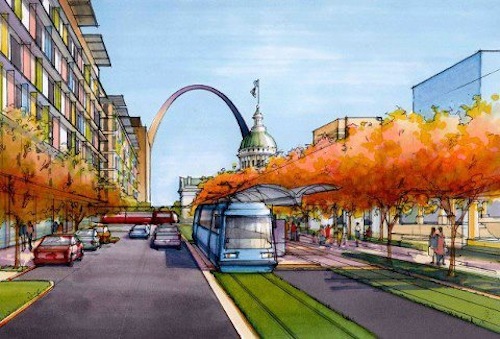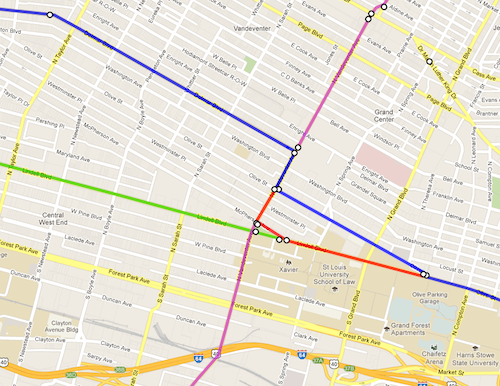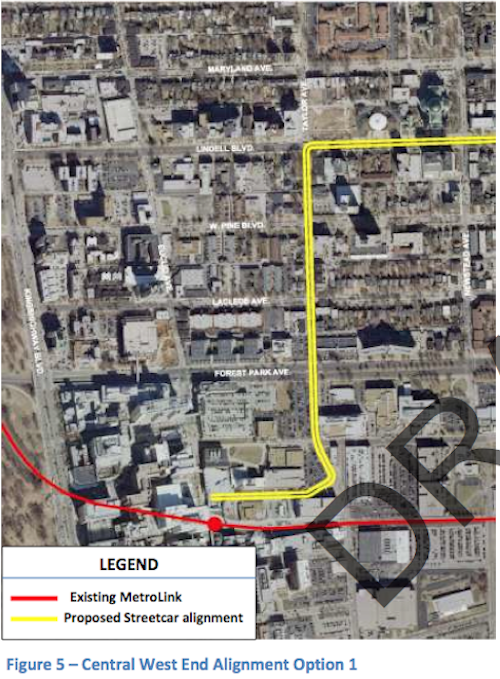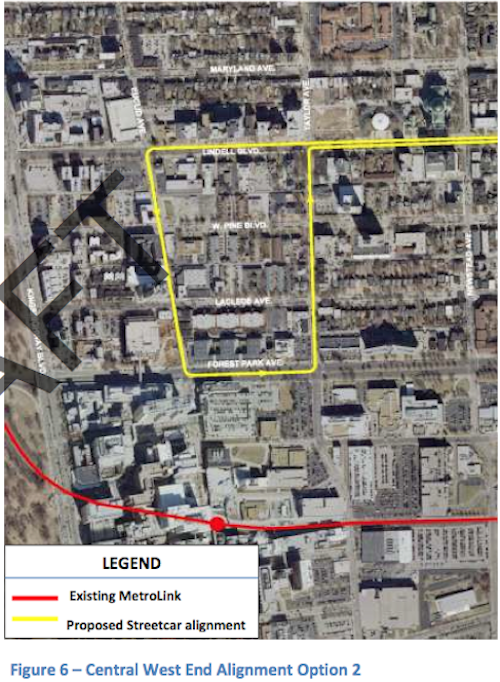Poll: What is Your Preferred Route For Streetcar Line West Out of Downtown St. Louis?
Plans were presented to the public last week to built a 7-mile modern streetcar line in St. Louis that would:
- Circulate in the downtown central business district.
- Head west on Olive/Lindell past Midtown to the Central West End.
- A north-south segment would connect at 14th Street & Olive, initially going north Florissant Rd to St. Louis Ave. and south to the Civic Center MetroBus Center/MetroLink light rail.
- Open in 2016/17.

Metro is part of the planning process and this would become part of our transit system. But I know some of you still question the effectiveness of the streetcar over the bus. To be fair, here is a skeptical view that I happen to agree with.
Streetcars that replace bus lines are not a mobility improvement. If you replace a bus with a streetcar on the same route, and make no other improvements, nobody will be able to get anywhere any faster than they could before. This makes streetcars quite different from most of the other transit investments being discussed today.
Where a streetcar is faster or more reliable than the bus route it replaced, this is because other improvements were made at the same time — improvements that could just as well have been made for the bus route. These improvements may have been politically packaged as part of the streetcar project, but they were logically independent, so their benefits are not really benefits of the streetcar as compared to the bus. (source – highly recommended)
He’s right that streetscape improvements are just as important as the mode of transit, but funding realities mean a complete makeover of 7 miles for a bus isn’t very likely. Even if it was, a streetcar is a better choice for other reasons:
Streetcar vs. Bus
Buses are excellent local and regional public transportation options, but they will do little to spur redevelopment and economic investment in Downtown LA. This is due to the inherent flexibility of bus service, as routes change regularly to accommodate varying needs; in addition, buses contribute to nerve-racking pedestrian experiences due to heavy street-level emissions and noise pollution that discourages active use of sidewalks. Streetcars do the exact opposite. They provide developers and business owners certainty that the routes will not change, and are considered preferable to buses by residents, visitors, and employees as they offer more amenities, highly reliable routes and timetables, and enhanced urban experiences.
Buses and streetcars do, however, work together to connect access points within regional transportation networks. For example, sidewalks can be designed to specifically accommodate both vehicle configurations; in return, a transit stop effectively doubles its value within a regional transportation network. (LA Streetcar)
And…
While it’s true that streetcars require a much larger initial capital investment than buses, that capital cost is offset by significant operational savings year to year. In the long term, streetcars are more affordable as long as they are used on high ridership routes.
Streetcars have higher passenger capacity than buses (even bendy ones), which means that if there are lots of riders on your route, you can move them with fewer vehicles. Fewer vehicles means more efficient use of fuel and fewer (unionized, pensioned) drivers to pay.
Streetcar vehicles themselves are much more sturdy than buses, and last many decades longer. While buses must generally be retired and replacements purchased about every 10 years, streetcars typically last 40 years or more. For example, Philadelphia’s SEPTA transit system is still using streetcar vehicles built in 1947. (Washington Post — recommended)
Even in Portland the value of streetcars have been debated, critics questioning claims of Mayor Hales:
So that brings us to the ruling. Hales said “streetcars carry more people than buses … you attract more riders who don’t ride transit now, and actually the operating costs are not any greater than the bus.” Whether these arguments make a persuasive case for the necessity and usefulness of a streetcar system is, of course, up for debate. The statement itself remains factual. While, there’s some missing context, it’s nothing significant. We rate this claim True. (PolitiFact Oregon)
For a detailed look at operating costs of streetcars vs bus click here. Labor tends to be a big factor why streetcars are cheaper to operate.
For the poll this week I want you to vote on your preferred route. I’ve included “don’t build” as an option as well as my idea of Olive to Vandeventer to Delmar: described here.

The poll also has the two options from the study (p17):


My views on a St. Louis streetcar are evolving, more on Wednesday March 20. The poll is in the right sidebar (mobile users need to switch to the desktop layout)
— Steve Patterson
Including your previous map in this post (instead of just the tiny link of “here”) would be useful.
Bigger picture, we need to look at the bigger picture. If we (as a community) decide to invest in streetcars, are we better off creating an east-west line, that essentially parallels Metrolink, or are we better creating a north-south line? Along Grand? Where there is already proven demand for transit and (other) potential redevelopment options? Or, should we focus on using streetcars for downtown circulators in St. Louis and/or Clayton?
Transit systems need to function as integrated systems. Throwing random technologies at random corridors without an overall plan or strategy pretty much guarantees failure, with low ridership and a need for large operating subsidies. Where do people want to go? When and why? Streetcars are cool, they’re fun to ride and they add an air of permanence, but they’re an expensive investment that you don’t want to screw up. Any new line will mean increasing taxes or diverting taxes from other projects, and you only have one chance to make a good first impression. Metro should be taking the lead here . . . .
I’ve added that map, thanks for the suggestion. Grand wouldn’t see great benefit from investment in a streetcar.
Why not Grand? Not necessarily criticizing, just curious.
The #70 Grand bus line is the busiest line in the city, thus the hardest to show a significant gain in ridership. Grand also lakes major attractions at each end, land along the route is already developed.
“The #70 Grand bus line is the busiest line in the city, thus the hardest to show a significant gain in ridership.” – that doesn’t follow at all. Grand is already TOD friendly and there are many more potential riders than in most other locations. Private cars thrive on uniform low density development, while transit thrives on high density development, which (except in the most highly populated areas) must be focused on a few points rather than the urban area as a whole.
Let’s look at what would happen if a streetcar replaced the #70. It would have fewer stops than the bus and would come just as frequently, but not more. Total ridership wouldn’t change. You wouldn’t see much new development either. Grand needs the lower cost BRT.
i don’t see that anyone suggests replacing the #70. a line from tucker/gravois west would connect a great proportion of the city’s population and it’s most diverse to the downtown. i would also showcase multiple distinct neighborhoods that make st louis a stand out among others.
Because grand avenue is not downtown, it can never replace downtown it can never replace a downtown performing arts center, it can never replace the region’s historic civic center-Soldiers Memorial and Aloe Plazas and the civic and government buildings that line the plazas. grand avenue is killing it again, but it can never replace it-ever.
This is all about transporting people from downtown to the Fox Theater. This is Schoemehl’s folly he wanted last decade. Kill Kiel downtown, and make the Fox flush with $$$$$, and that kills Downtown again.
Given my d’ruthers (and City coffers much more bountiful than what they currently are), the preferred option would be a South Side Metrolink running in the De Soto right-of-way, with supplemental streetcar lines feeding into/through it on Gravois and Grand, as well as a river-runner on Broadway from the Patch, through downtown (ahem, #buildtheblvd), and continuing along Broadway north from there.
These three stretches — Grand, Gravois and Broadway — have good “bones” and are wide enough to support the additional infrastructure, plus a hearty street diet on top of it. You can see how a push for renewal like the streetcar program “supposedly” provides could really improve the commercial viability for each.
[Edit: And yes, I’d feel much more comfortable if Metro were taking on the reins on this, integrating it into their system rather than working from a separate model.]
North and south St. Louis and north and south St. Louis County have been the victims fo the ‘center-cu’t powers for decades. That’s not going to change. The money and the power is from Grand west to Skinker between Clayton and Oakland and may be Delmar
sadly, in st. louis probably 90% of people in the middle/upper class will not ride buses; and this includes people of those classes who have chosen to move back into the city, even downtown. my dentist is on locust across from the rooster and lives on washington, he was surprised i chose to ride the bus from south city to downtown, and i was surprised that he drove 6 blocks from his home to work. these same people may however be willing to ride a streetcar, as they are currenlty willing to use metrolink for downtown events.
but i think JZ has a point that simply mirroring the existing metrolink line may not be the best use of funds (although it would hopefully kickstart development north of the CWE, which is why i voted for the delmar route). i hope that eventually this will spread to multiple lines, and i’m sure one on Grand would be in the next phase, but maybe starting with a north south line would be the best idea. i’ve always thought a line connecting cherokee, south grand, through midtown up to delmar (connecting to the new trolley) would be a great idea. and with a connection at the grand metrolink it would be an easy transfer to get into downtown.
Connections with MetroLink are important so as to function as a transit system. And the more exclusive lanes or medians the better, so that the trams can actually operate faster than buses. The Northside-Southside line could be built the same way, as modern trams (streetcar seems to implies heritage or mixed-traffic vehicles) in exclusive lanes or medians. MetroLink would remain the regional line, while MetroTram would be the east-west and north-south lines within the city.
The streetcar vehicles would be modern ones like Portland, Seattle, etc The planning problem is having the north-south connections dense enough to justify the infrastructure. Connecting Saint Louis University to the new SLU Law School building downtwn was what got this going.
Metrolink’s Grand Station is pretty much midway between SLU’s main campus and SLU’s Medical Center, and Metrolink’s Civic Center Station is 6-7 blocks from SLU’s new Law School Building (at Tucker & Chestnut). SLU’s Law School has 930 students and 100 faculty members (http://grad-schools.usnews.rankingsandreviews.com/best-graduate-schools/top-law-schools/st.-louis-university-03089 . . .). Yes, that “last mile”, on both ends, ain’t great, so to “better serve” a new, remote SLU facility, with a total of 1000-1200 students, faculty and staff, with something other than a dedicated bus line, we’re going to look at investing $200 million – $300 million?! Primarily from public taxes?! That’s $165,000 – $250,000 for each student, faculty member and staff member at the Law School! Add in the stark reality that the trip won’t be quick (” Central West End to downtown is 40 minutes by streetcar and 13 minutes by MetroLink . . . “) and you’ve moved into Pentagon-level spending logic . . . .
We continue to deride the podunk towns in St. Louis County that buy into developers’ arguments that they “need” TIF’s to bring any commercial project to fruition, yet you (and others) seem more than willing to ignore the fiscal realities of spending hundreds of millions of dollars in tax dollars to replace a part of the existing #10 bus line with a streetcar line that won’t be significantly quicker. I have no problem with SLU and Fr. Biondi spending that kind of money to enhance their students’ college experience, I just see little justification for a public investment, especially when many, many other parts Metro’s service area have no, little or inadequate transit service, of any type. Public transit’s first priority should be moving as many riders as possible to as many destinations as possible as efficiently as possible; supporting development schemes should be a distant second.
The fact that SLU wanted to run shutte buses from their main campus to the new Law School was the thing that got this ball rolling but that couldn’t remotely justify the expense. That’s why it’s broader and includes a north-south section on 14th.
No, you dont know your history, Steve. This ball was ‘shaped’ a decade ago. It’s just been stitched up, and they are ready to throw it at taxpayers. I proposed a trolley on rubber tires that could go to grand but come back down past Union Station and Kiel Opera House. That would not be allowed by the owners of the Fox.
Then this should be a METROLink project? Anyone ask them what they think?
The only way they would increase ridership is where commuters who have cars, become willing to give them up. Busses already serve areas where either commuters don’t own cars or if they do, they don’t want to give them up. It means a step backwards socially.
The only other way streetcars would be seen as an improvement or upgrade, is if they ran more often and more consistently than the buses they replace.
Streetcars offer more amenties? Like what? At 100’s of millions, they darn well out to have waitress service and in flight movies. People keep grasping at the past. Spending all that money is wasteful. We have busses, if they aren’t going to use a bus, they aren’t going to use a flashy trolly with “amenities”.
Ahem, the National Highway System is ‘the past’. TrillionsUSD’s worth, I might add. We’ve got a monkey on our backs, and it is called the automobile. Whether our fix comes from oil, or grid-generated electricity, an addiction is still an addiction. We spent 2 BillionUSD per (not counting the estimated 15-35 BillionUSD development costs) B2 bomber, of which we purchased 20, if I’m not mistaken. 2 Billion per on your average 90,000 or 100,000 ton aircraft carrier (of which we have twelve, with a new 110,000 ton class on the drawing boards), minus all of the cruisers and destroyers needed to keep them from being blown out of the water by an Exocet or Silkworm missile. 2 TrillionUSD for the two major wars we’ve started over the last decade. And 2 Trillion more expected, from current estimates. How many subway systems, light rail lines, streetcar lines, bridges, roads, dollars for full funding of National Parks, schools, healthcare (single-payer, think France or Canada, or at the very least, a highly-regulated universal system, a la Swiss and German models), would those monies have purchased? Revenue, and the allocation of same, is the problem. Not deficits, and ‘austerity’ is obviously not only not working, it is presently bringing about the collapse of Greece, and will soon do the same for Spain, with the possibility of Italy, Ireland, and Portugal joining them. Britain is a longshot, and we’re attempting to follow them all into the abyss.
Oh, and the cost of the aircraft carrier doesn’t include the aircraft. That item is sold separately.
My vote…build North/South lines first…Hampton/Grand/KHWBlvd/Jeff and the like. Tie those in with the existing LRT line. East/West lines are needed but we might as well leverage the existing LRT as much as possible. I’d jump at the opportunity to ditch the car and take a combo of LRT and streetcar to downtown (or elsewhere). I’m one of those middle class cats that just isn’t interested in the bus…Steve’s points covered the reasons.
Not the business district your dummies, to the attractions, like other cities. And in other cities downtown performing arts centers are the major year round attractions. No, not Schoemehl’s trolley out to the Fox and Powell Hall. But Washington Avenue, over Broadway or 4th to
Market, up Market to Union Station in front of the opera house, not behind it. And in the Park-restore METRO express from St. Louis County to MUNY.
I have to agree with JZ, a more comprehensive approach is in order. Would you build the living and dining room of a home and then come back a year later and build the kitchen and bath a hundred feet away? That is what we are doing with transit.
The Loop trolley, if a failure, will harm transit for years. Any well intentioned piecemeal streetcar line could offer the same results. Yet it does not represent the potential of streetcars within a viable transit system.
Streetcars were robust players in America until the oil cartels bought them out and shut them down. They are still important to transit systems for much of the rest of the world. Streetcars are not nostalgia, but offer the potential for real solutions. When combined with buses, trains and light rail they can help establish a transit system that is effective and useful. It is not hard to find a transit system more effective than St. Louis.
A comprehensive approach does not mean build out everything at once, but rather present a framework of solutions that can work.
Take your contention that Grand Ave could not be a streetcar line. If urban planning and zoning are taken into account then the vacant area around the metro link station at Grand and the largely vacant land North of Grand Center up to Highway 70 can be used to create the density needed to support transit. Even with all of this vacant land the Grand Ave line is still among the most heavily used in the region.
The question becomes how to organize (note the word organize) the system in a way to take advantage of transit gathering spaces (public space), of which there is very little in St. Louis.
In fact I would argue that Grand Ave, with its large amount of transit ridership actually is a prime candidate for streetcars. It offers the chance to organize transit in a way to enhance ridership by building on the already heavy use to create nodes of transit headed other directions, making many new connections.
Finally I agree that new east west lines are not needed at this time. There are no north south rail/streetcar lines of any kind. An analysis of the current transit system will reveal many faults, in fact I would rate the current transit system just above junk status in its implementation,
I just don’t understand how a preferred east-west line can be cited without understanding the goals and concepts of the overall transit system.
We don’t need a Downtown trolley ‘out of Downtown and west to the front doors of Powell Hall and the Fox’, not for hundreds of millions of dollars. Nope, we have a downtown trolley that gets people from here to there, on rubber tires. It works. That it does not go by Kiel Opera House which is still criminally restricted, is significant. So ‘free’ the opera house and route the METRO bus up or down Market Street, to Union Station, cut over to Washington, down to whatever, over to Market and back up market. A city without a downtown performing arts center does not exist. Dallas and Kansas City are the latest to help St. Louis to ‘no longer exist’.
You have the classic St. Louis mindset, you think one magic bullet is the answer. Not everyone places the same priority on performing arts. I live very close to the Peabody and there’s an upcoming show I’d like to see — but I can’t afford the tickets.